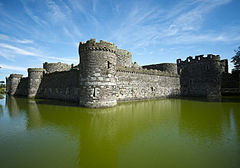Beaumaris
Beaumaris
|
|
|---|---|
 Beaumaris Castle |
|
| Beaumaris shown within Anglesey | |
| Population | 1,938 (2011) |
| OS grid reference | SH6076 |
| Community |
|
| Principal area | |
| Ceremonial county | |
| Country | Wales |
| Sovereign state | United Kingdom |
| Post town | BEAUMARIS |
| Postcode district | LL58 |
| Dialling code | 01248 |
| Police | North Wales |
| Fire | North Wales |
| Ambulance | Welsh |
| EU Parliament | Wales |
| UK Parliament | |
| Welsh Assembly | |
Beaumaris (/bjuːˈmærᵻs/; Welsh: Biwmares [bɪuˈmɑːrɛs]) is a former royal borough, a community, and the former county town of Anglesey, Wales. It was located in the commote of Dindaethwy and historic rural deanery of Tindaethwy, and is at the eastern entrance to the Menai Strait, the tidal waterway separating Anglesey from the coast of North Wales. At the 2001 census it had a population of 2,040, reducing to 1,938 at the 2011 Census.
Beaumaris was originally a Viking settlement known as Porth y Wygyr ("Port of the Vikings"), but the town itself began its development in 1295 when Edward I of England, having conquered Wales, commissioned the building of Beaumaris Castle as part of a chain of fortifications around the North Wales coast (others include Conwy, Caernarfon and Harlech).
The castle was built on a marsh and that is where it found its name; the French builders called it beaux marais which translates as "beautiful marshes".
The ancient village of Llanfaes, a mile to the north of Beaumaris, had been occupied by the Anglo-Saxons in 818 but had been regained by Merfyn Frych, King of Gwynedd, and remained a vital strategic settlement. To counter further Welsh uprisings, and to ensure control of the Menai Strait, Edward I chose the flat coastal plain as the place to build Beaumaris Castle. The castle was designed by the Savoyard mason Master James of St George and is considered the most perfect example of a concentric castle. The 'troublesome' residents of Llanfaes were removed en bloc to Rhosyr in the west of Anglesey, a new settlement King Edward entitled "Newborough". French and English masons were brought in to construct the castle itself and the walled town.
...
Wikipedia

